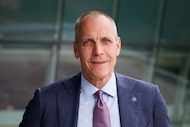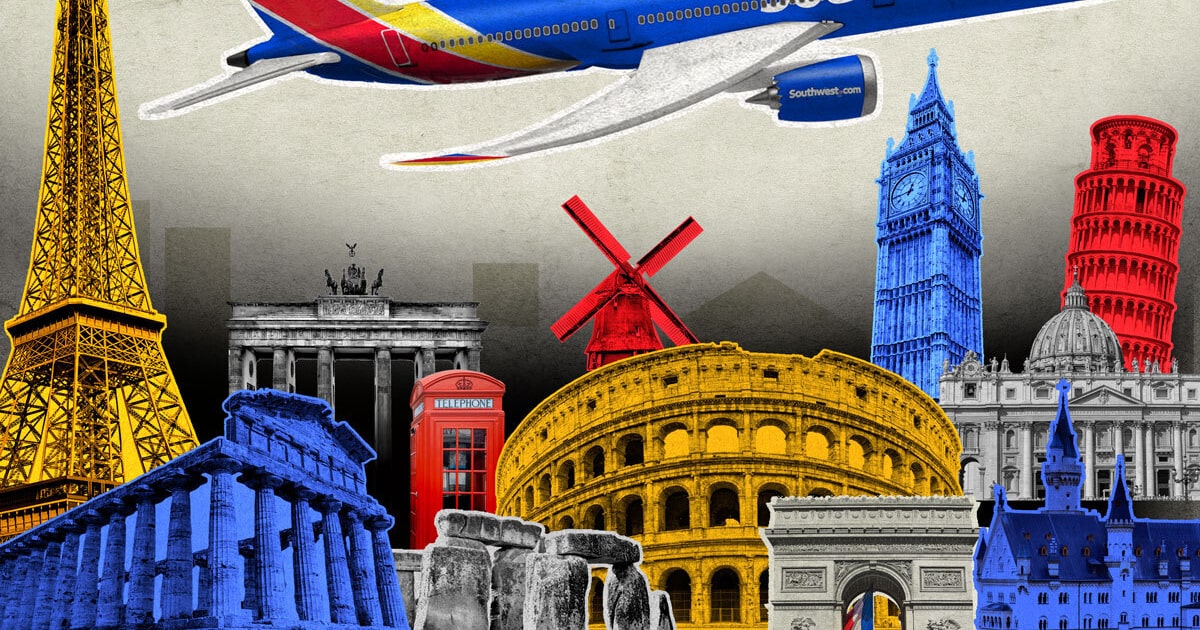Southwest Airlines could be on the cusp of making the most monumental change of its 54-year history.
The Dallas-based carrier has rolled back some of its most popular policies as it positions itself to take on other major U.S. carriers. Now it may be eyeing an expansion to long-haul flights to Europe for the first time.
Southwest officials said in August that the airline was talking to the unions representing its pilots and flight attendants about expanding its international route network beyond Mexico and the Caribbean.
Southwest’s longest route is currently Phoenix to Honolulu, about 2,900 miles. This year, Southwest has also launched international airline agreements with Iceland Air, China Airlines and EVA Air in Taiwan, further signaling its intention to explore international opportunities.
Business Briefing
Yet that may be changing, with Southwest flirting with expanding its global reach at a time when rival carriers are beefing up their international schedules. Fort Worth-based American Airlines is set to add flights from DFW International Airport to Athens, Greece, and Zurich next summer, in addition to extending service to Buenos Aires, Argentina.
Meanwhile, Delta Air Lines is expanding service to destinations in Portugal, Italy, Spain and France, as well as the islands Sardinia and Malta next summer. And United Airlines added routes from its Newark hub to Italy, Croatia, Scotland and Spain.
Bob Jordan, Southwest’s chief executive, has not been shy in talking about the chances of his carrier embarking on an international expansion, saying at a summit last month that “everything is on the table.”
“I wouldn’t be talking about things like lounges, premium and long-haul international if it wasn’t a real subject under evaluation at Southwest Airlines,” Jordan said at the North Dallas Chamber of Commerce’s annual aviation breakfast last week. ”If we were to decide that we want to fly long-haul international, it would require a different aircraft. The 737 cannot do that. It would require negotiations with our pilots and flight attendants. It would require learning how to do catering. It would require getting slots in the airport’s we want to fly to in Europe, as an example.”
Jordan indirectly hinted at two possible Southwest destinations if it were to fly to Europe.
“The number one long-haul destination in the world to the United States is London, number two is Paris,” Jordan said at the breakfast. “So you take the top 10 (long-haul markets), most of those are western Europe. It would be logical if we were to fly long-haul international that you would want to pick off the top markets, right?”
The unions representing Southwest’s flight attendants and pilots both declined to comment to The Dallas Morning News, as did a spokesperson for an agency representing TWU Local 556, the flight attendants union, citing a nondisclosure agreement. Southwest also did not respond to a request for comment from The News.
Even still, a number of analysts have doubts that international routes beckon for the airline.
“The key thing here is just because an airline says they’re going to explore doing something doesn’t mean they’re actually going to do that thing,” Henry Harteveldt, founder of Atmosphere Research Group, told The News.
“It’s easy to talk about exploring long-haul flying,” he said, suggesting that Elliott Investment Management — the activist investor that’s forced major change at Southwest — may be pressuring the airline to do more global travel.
“There are a lot of questions [that] have to be answered before an airline pulls the trigger to go long-haul,” Harteveldt added.
“For more than 50 years, they’ve been a primarily domestic airline. They’ve been an airline that flies to Mexico, the Caribbean and Central America, but nobody right now thinks of Southwest as being a long-haul airline, and that’s a big change to make in the consumer’s mindset,” he said.
“I’m not sure that the Southwest brand footprint, in most of its customers’ minds, extends to flying to Europe.”
‘High risk, high return’
An American Eagle Embraer ERJ 175 is backed away from the gate alongside JetBlue and Southwest aircraft at LaGuardia Airport in East Elmhurst, New York, October 6, 2025.
Tom Fox / Staff Photographer
At a time when Southwest is still digesting a broad-based overhaul designed to generate more revenue, an overseas expansion would be an extremely consequential change. Recent changes include the elimination of its longstanding policy of free checked bags earlier this year and rolling out assigned and premium seating options in January.
Amid the whirlwind of changes, “Southwest could find itself in a high-risk, high-return situation,” Usha Haley, a business professor at Wichita State University, said in an email.
“Historically, Southwest has focused on short-haul, high-frequency routes with fast aircraft turnarounds and low operational costs,” she said.
“Long-haul international flights introduce complexities including larger aircraft, training international crew, overnight stays, and higher regulatory compliance, all of which could hurt Southwest’s cost advantages and endanger its brand name. As sometimes happens, Southwest may find that it has bitten off more than it can chew.”
From the Texas Triangle to rough skies
Southwest first took flight in 1971 from Dallas Love Field to San Antonio. At the time, the carrier only operated within the “Texas Triangle,” flying between Dallas, Houston and San Antonio. Today it offers flights to more than 117 airports across 11 countries, according to its website. Southwest is the dominant carrier at Love Field, operating 18 of the airport’s 20 gates.
Southwest eventually expanded to cities outside Texas beginning in 1979. Historically, the carrier has used “point-to-point” flying — meaning direct service between two cities — instead of a centralized hub like its major domestic competitors.
When given the opportunity, the airline has expanded aggressively, such as when it began flights from the Western U.S. to Hawaii in 2019. Southwest currently flies to the Hawaiian islands from Las Vegas and Phoenix, and from California cities Sacramento, San Jose, Oakland, Los Angeles, Long Beach and San Diego.
The light international footprint model worked for more than four decades, with Southwest racking up 47 straight years of profitability, solidifying itself as one of the most successful airlines in the world. But it has struggled financially since the COVID-19 pandemic, lagging behind competitors like United and Delta as other challenges mounted simultaneously.
It managed the grounding of one of its most popular jets, the Boeing 737 Max, after the aircraft suffered two fatal crashes in Indonesia and Ethiopia that were linked to a faulty software system. The nearly two-year halt forced Southwest to cancel thousands of flights.
Infamously, Southwest suffered a catastrophic meltdown in December 2022, when it was forced to cancel flights amid freezing temperatures, ice and snow — which left the company’s technology unable to keep up with reassigning pilots and flight attendants. It had to shut down most of its network to reset, leaving over 2 million passengers stranded during the key holiday period.
The meltdown cost the airline more than $1.1 billion.
The 737 Question
Southwest has almost exclusively operated the Boeing 737 family of aircraft since its beginning. The carrier currently operates 810 aircraft: 334 Boeing 737-700 aircraft, 203 Boeing 737-800 aircraft and 273 Boeing 737 MAX 8 aircraft. The airline has credited its single-aircraft policy with efficiency and scheduling simplicity over airlines that fly multiple airplanes from different manufacturers.
In order to fly long-haul international routes, Southwest would likely need to diversify its fleet. In comparison, major U.S. carriers that fly internationally, such as United, American and Delta, operate a variety of aircraft from Boeing, Airbus and regional operators. Delta operates more than 930 aircraft, consisting of both Airbus and Boeing, as well regional Bombardier and Embraer aircraft. United Airlines operates 938 mainline aircraft. American Airlines recently took delivery of its 1,000th mainline aircraft.
The company’s single-aircraft model limits its flying, since the 737 MAX has a maximum range of about 3,500 miles. That’s why the company only flies to Hawaii from western U.S. airports. New York to London, for example, would push the aircraft’s range to the maximum with a distance of about 3,450 miles.
“In Southwest’s case, they have 737 MAX jets and they can potentially modify some of their MAX 8 jets to fly long-haul by adding a fuel tank,” said Harteveldt. “Flying the 737 MAX 8 could allow Southwest, conceivably, to fly from airports in the Northeast U.S. to destinations in Northern Europe.”
Southwest could run into issues if it aims to acquire new aircraft. Earlier this year, Airbus warned of delays in new aircraft deliveries as it slogs through supply-chain issues, and Boeing is also facing similar problems.
“My first thought … was where are they going to get the planes because everybody is sold out for like 10 years,” said Bruce McClelland, a senior contributing analyst at Teal Group. “Both Boeing and Airbus are having trouble meeting their delivery commitments, especially for the larger airplanes, which is what you kind of need for an international service.”
McClelland said the company could explore other options, such as the Airbus A321 XLR or Boeing 787. The range of the XLR is 11 hours or about 5,400 miles. The 787, often referred to as the Dreamliner, has a range between 7,200 and 8,700, depending on the model.
“As I think about Southwest and its legacy, its history and its philosophy, and everything else, I mean to me the most likely airplane that they would choose is 787, not an Airbus.”
While speaking at the Morgan Stanley Laguna Conference last month, Jordan hinted that Southwest may opt for a narrowbody for long-haul routes, The Points Guy reported.
“Don’t be surprised if we go a more risk-tolerant route at first and choose a narrowbody” for long-haul flights, Jordan reportedly told investors.
Still, Southwest’s transition into a more global player won’t come easy or quickly.
Analysts that The News spoke with pointed out that Southwest will need to overhaul its operation and product if it wants to enter the long-haul market. They questioned how Southwest would implement such routes given that it has no major international hubs, and no premium loyalty products enjoyed by its rivals — such as lounges and top-end offerings offered to premium and business travelers.
Clark Johns, director of the Alton Aviation Consultancy, said Southwest would need to examine how an international expansion would impact its business model.
“There is potential for them to ‘win’ customers who utilize Southwest for their domestic travel today, but then are required to split their wallet with other airlines when it comes to long-haul travel,” Johns said in an email to The News.
Southwest also faces the challenge of convincing customers to buy-in to a drastic change such as international long-haul flights, which strays away from the original mission the carrier established when it first launched service.
Suzanne Sullivan, an avid Southwest traveler based in San Antonio, said she would try a long-haul flight with the carrier on the condition that the airline could offer a similar product to major international airlines such as Cathay Pacific or Qantas. But she worried about how high a premium Southwest could charge.
“All of those things cost money, which will absolutely be passed along to the flyers because Elliott Management wants to squeeze as much profit out of Southwest as possible,” Sullivan told The News via social media direct message.
“Southwest could be making money hand over fist by being excellent at the things they were already doing.”
The Elliott effect
Sixteen months have passed since Elliott acquired a nearly $2 billion stake in Southwest, allowing it to turn up the pressure on leadership. When the firm burst onto the scene, it came with a mandate for Southwest management: increase profit by overhauling its strategy.
The fallout saw former Southwest CEO and executive chairman Gary Kelly retire early, and six other board members resigned last year before Southwest and Elliott settled their feud.
As part of the agreement, five members nominated by Elliott were appointed to the airline’s board of directors. However, Jordan was able to keep his post after Elliott previously called for him to be removed.
Amid the chaos, Southwest made major policy moves like ending open seating, announcing overnight flights and charging for checked baggage, among other changes. When all is said and done, the Elliott feud could be a catalyst behind why Southwest is considering yet another dramatic strategy shift.
“So there are a lot of factors that Southwest would have to consider, and they may conclude that again, the economics of flying long-haul aren’t as compelling as remaining a primarily North American-focused airline,” said Harteveldt.
“And guess what? That’s okay. Because if Southwest believes it can actually make more money with a North American network, then that is the message it has to tell Elliott and its other investors.”
Why would Southwest do it?
With its missteps in the rearview mirror but external pressure mounting to hasten its modernization, an international expansion could give Southwest access to profitable routes.
As post-COVID international travel picks up, there’s money to be made for savvy carriers. Collectively, U.S. airlines made a $1.8 billion net profit from international operations, according to U.S. Department of Transportation statistics from the second quarter — a jump from the comparable year-ago quarter.
“When it comes to airfares, travelers could win big if Southwest enters the long-haul market,” said Julian Kheel, the CEO of Points Path, a company that helps travelers utilize rewards points.
“More competition on routes to Europe or South America would likely mean lower ticket prices and better award availability across the board,” she said, while warning that Southwest “would have a lot of work to do to match the international flight experience passengers expect from global airlines.”
But he added that “more competition is always a win for travelers, and if Southwest pushes other carriers to lower fares or improve service, consumers will benefit in the long run.”
The airline could also be feeling pressure to perform against its rival domestic carriers, like Delta and United, which Southwest trailed financially in recent years. More recently, the company reported $54 million in third-quarter earnings, a profit, but down from $67 million a year ago.
“The financial rewards of success also seem clear. U.S. carriers are experiencing high demand for trans-Atlantic and trans-Pacific travel,” said Haley.
“High margins on long-haul routes can follow if fuel prices and load factors hold steady. Southwest’s decision will probably hinge on whether it can maintain its low-cost roots while investing in the infrastructure, fleet, and partnerships needed for global expansion.”
 Southwest Airlines launches free Wi-Fi today
Southwest Airlines launches free Wi-Fi today
Only Rapid Rewards members will get the free service.
 Is there an airline disruptor on board?
Is there an airline disruptor on board?
The startup ecosystem is all about disruption, and there are few sectors in more acute need of being disrupted than commercial aviation.
 American Airlines taps new chief commercial officer
American Airlines taps new chief commercial officer
The carrier is aiming to compete with United and Delta.

